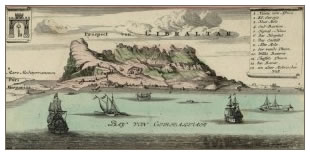Gibraltar and the Beginnings of an Emporium
 Gibraltar lies on a small peninsular at the Southernmost tip of Western Europe, overlooking the Strait of Gibraltar, the North African Coast and Spain. The Rock runs from North to South for a length of nearly three miles. It is three quarters of a mile wide and has a total area of two and a quarter square miles. The highest point is 1396 feet above sea level. The total civilian population of Gibraltar is approximately 30,000 inhabitants, of which just over 20,000 are native Gibraltarians. English is the official language, although most Gibraltarians are fluent in both English and Spanish.
Gibraltar lies on a small peninsular at the Southernmost tip of Western Europe, overlooking the Strait of Gibraltar, the North African Coast and Spain. The Rock runs from North to South for a length of nearly three miles. It is three quarters of a mile wide and has a total area of two and a quarter square miles. The highest point is 1396 feet above sea level. The total civilian population of Gibraltar is approximately 30,000 inhabitants, of which just over 20,000 are native Gibraltarians. English is the official language, although most Gibraltarians are fluent in both English and Spanish.
Gibraltar was occupied successively by the Phoenicians, Carthaginians and the Romans but remained uninhabited until the conquest of Al-Andalus by the Arabs and thereafter alternated between Muslim and Christian occupation from 711 to 1704. During the War of the Spanish Succession, Gibraltar was captured by Anglo-Dutch forces under the command of Admiral Sir George Rooke, and was ceded to the British Crown by the Treaty of Utrecht in 1713. It has remained British ever since despite several attempts to recapture it.
From the moment Admiral Sir George Rooke blasted the city of Gibraltar with his canon in 1704, all but a handful of the resident Spaniards moved out. The absence of a civilian population and the arrival of troops created a new generation of entrepreneurs. Despite the terms of the 1713 Treaty of Utrecht which forbade the presence of Jews and Moors in the garrison, the British made use of those who returned from North Africa in order to keep the garrison in good supply.
By the mid-1700’s, Italian merchants from Genoa in particular, seized the opportunity for trading. With a tradition of supplying the Army, Navy and local market, many of today’s prominent merchants can trace their roots back to the 18th Century when they established their fortunes. Migration to Gibraltar continued due to the attraction of jobs generated by the British, who had started developing the military base after the end of the Great Siege in 1783. The success of these settlers resulted not only from their permanence, because British Officers came and went, but the fact that in the early years, the British Navy provided protection from pirates, allowing trade by sea to flourish.
The great commercial boom of the early 19th Century was when Gibraltar became a major entrepot of British goods. This attracted another wave of immigration, mainly from Italy such as the first Sacarello to arrive.

